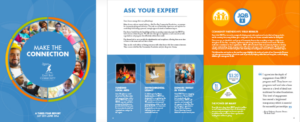Your Annual Report Question: Deliver Digitally, By Mail, Or Not At All?
Posted by Jennie Winton on September 29th, 2015
Posted in Blog, Nonprofit Annual Report, Nonprofit Communications, Nonprofit Messaging Tags: annual report

Note from Jennie: It’s interesting that this is a question that still gets asked today, three years after I originally wrote this. And that’s because each nonprofit, foundation, and independent school must find the answer that’s right for them. Do your donors engage with you more online than they do with your printed communications? No matter how you approach your annual report, we’ve outlined the pros and cons of each format below so you can make a clear and informed decision for your organization.
In today’s digital world you may be wondering if printing and mailing an annual report to your supporters is appropriate. And if your budget is tight you may have already decided to save the print and postage costs by emailing a report instead, or simply posting it somewhere on your website.
We’ve written previously on how to make your annual report the best it can be. Here’s a look at how you can decide what format report to develop this year.
Identify Your Goals
Any effective communication starts by very specifically answering the following questions:
- Who am I trying to reach with this annual report?
- What action do I want them to take after reading it?
When you know your donor audience and you’re clear on what you’re asking them to do after reading your report, it’s much easier to decide what to include, why to include it, and how to present the material. Don’t skip this step. And be precise.
If you’re like most nonprofits today you have a range of donors with varying levels of technology prowess. Older donors who write checks or direct their donor advised fund manager to issue funds to you may enjoy a printed annual report, while younger donors who donate online may prefer a digital report. That means you may need to develop reports for both formats.
Content Is Still King
The format doesn’t matter unless you’ve created a great communications piece. It has to be delivered the way your donors want it, and it has to be powerful and engaging to read, regardless of whether your donor is on her laptop, mobile device, or sitting in the comfort of her living room with your printed report in her hand.
A good annual report, sent to your donors by any means, is the chance to show your organization’s impact and continued need to an audience most likely to support you in the future.
Your annual report is a fundraising tool. It’s not just a financials and impact report. Its goal is to stoke your donors into continuing their financial support of your work. So what will stoke them more? A printed report they receive in the mail, or an email from you alerting them that the report is available online?
Neither of these will work unless the report itself captures attention, stirs emotion, and is delivered the way the donor wants to receive it.
Don’t Cut Corners
Note that many nonprofits make the mistake of thinking that they can save money by just publishing their annual report on their website as a PDF and calling it done. If your digital report looks like a typical 8-1/2 x 11” print document it’s not going to be read by anyone other than your CFO. Its content needs to be deeply considered, its design deeply engaging, and its interface easy and irresistible to use.
Developing a strong annual report takes time and it takes budget. If you mean business with your annual report, and you recognize it for what it is – one of your most important communications and fundraising tools of the year – then plan to spend the time and the money to create one that gets your donors’ attention regardless of the medium you choose.
The Pros and The Cons
Here are the pros and cons of printed vs. digital annual reports:
Printed Annual Report
| PRO | CON |
| Unexpected in today’s digital world so it can really stand out, get attention. | Must be beautifully written and designed to pass the “toss in the junk mail pile” test. |
| Has staying power. Donor may keep it or share it with family. | Will donors consider it a waste of resources? |
| In a digital world, printed reports can add gravitas to your organization. | Cost of printing and postage. |
| Donors’ tactile experience with the content may leave a stronger, deeper impression. |
Digital Annual Report
| PRO | CON |
| Opportunity to communicate with digital donors on the go. | Must be beautifully written and designed in order to pass the “is this worth my time?” filter. |
| Easy to share with others if donor is truly moved. | Will donor truly engage with the material? |
| Can be interactive and deeply engaging. | Cost of digital report production. |
Consider Solving Your Challenge In Multiple Ways
Even a beautifully designed report that you invest in printing and mailing is not web-ready. It was designed for print, not for reading on a screen. If you post it to your website it’s a document that won’t get attention, and won’t send the right signals even if a donor does find her way to it.
East Bay Community Foundation wanted to share its impact so it created a printed report for distribution to some stakeholders and an interactive digital report for others. Take a look and note the difference between the two.

Khan Academy decided to take their annual report online. We helped build a microsite for their annual report that highlighted their accomplishments for the year in the form of compelling videos, testimonials, and infographics.
Are you ready to take the next step? Take a look at our step-by-step guide to creating your best annual report yet.
Jennie Winton is a Founding Partner of Mission Minded, a 25-year marketing veteran sought for her expertise in branding nonprofit organizations, and a one-on-one leadership coach.
See all posts by Jennie Winton